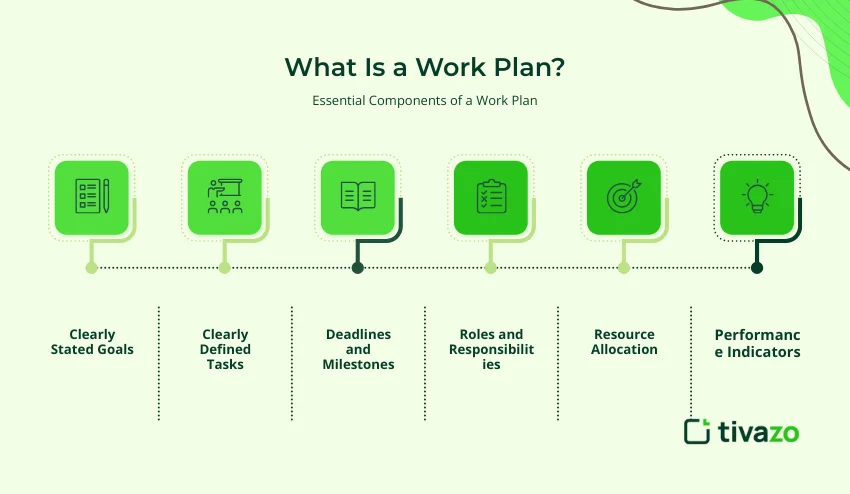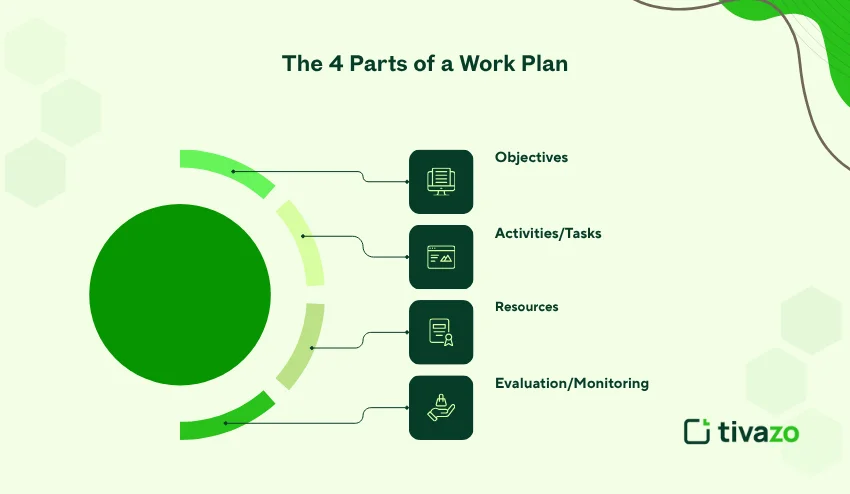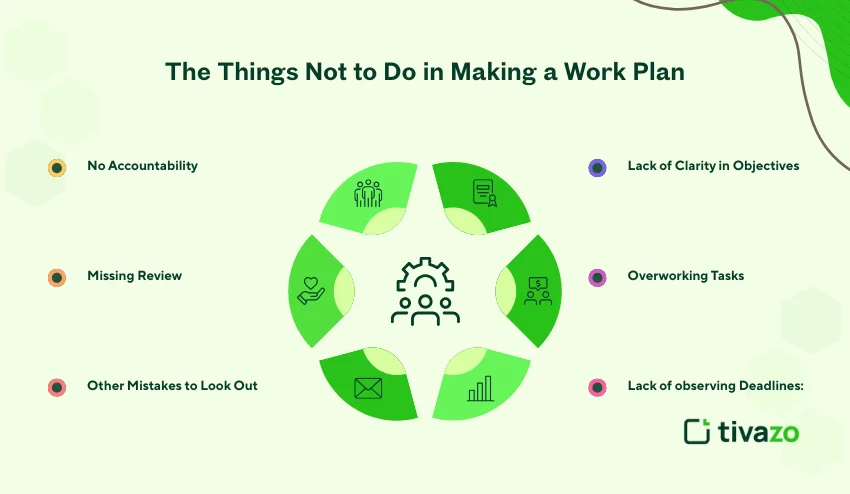One of the most important skills in maximizing individual productivity and organizational efficiency is the ability to form a work plan. It does not matter whether you are in control of a project, leading a team, or just planning to do something on your own; a systematic work plan makes sure that you have clear goals, dates, and responsibilities. This guide will show you all you need to know about writing an effective work plan with examples, steps, and important tips.
What Is a Work Plan?
A work plan is a document that is organized and contains details of tasks, duties, schedules, and other resources needed to accomplish definite goals. It serves as a map, which helps direct individuals and teams on how they can achieve objectives in an efficient manner. A properly developed work plan not only indicates what should be done, but it also offers a clear flow of actions, accountability, and identifies possible challenges that can be expected beforehand. It is used as a communication tool between team members and allows them to be more coordinated and collaborate.
A work plan ensures that the expectations are clearly defined, the schedule is established, and the chances of a successful project completion are high because of the minimization of confusion, delays, and the chances of failure.
Essential Components of a Work Plan:
- Clearly Stated Goals
- Clearly Defined Tasks
- Deadlines and Milestones
- Roles and Responsibilities
- Resource Allocation
- Performance Indicators

A good work plan has several benefits
Supports Focus: A good work plan helps you to focus on the work in a prioritized way to ensure that key work activity gets done first.
Improves Productivity: It saves time that is wasted on ambiguous assignments and removes confusion, enabling individuals and workgroups to be more productive.
Provides accountability: Role and responsibilities are allocated clearly; hence, everyone knows their roles and can be held accountable for results.
Enables Tracking: Eases the process of tracking progress, and thus delays can be avoided, and timely adjustments can be made.
Enhances Co-ordination: Unites the team members by setting goals that all team members strive to achieve, enhancing cooperation and communication.
Facilitates Achievement of Goals: Maintains the team on the long-term goals and copes with short-term assignments.
Eliminates the risk of making mistakes: Planning helps in the early detection of possible additional challenges, which reduces errors and improves the execution process.
Increases Motivation: Have a direction and purpose: Having clear plans will provide team members with a sense of direction and purpose that will enhance engagement and morale.
Not only does a good work plan help to organize the tasks, but it also gives the teams the ability to work more strategically and deliver their results.
Simple Work Plan How-to-do

It does not have to be a complex process to write a simple work plan. Follow these steps:
- Set Your Goals: Begin with goals.
- Write down Tasks: Plan goals into action tasks.
- Establish Deadlines: Have times for the accomplishment of every task.
- Allocate duties: Decision on who does what.
- Resource Allocation: Determine the tools/resources required.
- Review and Adjust: Check the progress and implement the needed changes.
Simple Work Plan Example Table
| Task | Person in charge | Deadline | Resources required |
| Research Topic | John | Nov 25, 2025 | Laptop, Internet. |
| Draft Report | Sarah | Nov 30, 2025 | Word Processor |
| Review and Edit | Team Lead | Dec 3, 2025 | Feedback Tools |
| Final Submission | John and Sarah | Dec 5, 2025 | Printer/Email |
What Are the 5 Steps of a Work Plan?
In designing a work plan, there are steps to be taken that will then translate objectives into results. Here are the 5 essential steps:
- Goal Identification: Find out what you want to accomplish. Goals that are clearly defined give direction and purpose, therefore putting the energy into what matters.
- Task Identification: State all the tasks that are required to achieve your goal. The plan is also actionable and easy to follow when it is broken down into small, manageable tasks.
- Creation of Timeline: Establish dates and targets of every activity. Having a clear timetable ensures that the job is done at the right time, and it also aids in prioritizing work.
- Responsibility Assignment: Divide responsibilities among the people or groups. Having actual roles specifies what needs to be done, it facilitates accountability, and each task is assigned an owner.
- Monitoring and Evaluation: Keep track and make alterations. Frequent checking can enable you to be aware of the challenges at the start, carry out the required adjustments, and keep the plan on track.
These steps will help you organize your work plan, make it practical and goal-oriented, and thereby make it more effective and increase the chances of success.
The 4 Parts of a Work Plan
There are 4 main components in a detailed work plan:

- Objectives: What is the plan supposed to accomplish? Specific goals are a guide and can also be used to evaluate achievement.
- Activities/Tasks: Specific steps to attain goals. Dividing tasks into steps to be taken helps in being clear and accountable.
- Resources: Time, money, and resources needed. The predetermination of the resources eliminates delays and ensures that tasks are done efficiently.
- Evaluation/Monitoring: The way progress and outcomes will be assessed. It should be monitored regularly to be able to make adjustments, detect any possible problems as soon as possible, and ensure that the plan is on track.
All these four components work in unison to develop a systematic process that increases productivity, accountability, and the timely attainment of goals. A clear work plan may be an effective instrument for individuals and a team, and guarantees an individual and an organization good performance.
Writing a Work Plan: How to Do It
The following is an effective example of a work plan for a small project:
Project: Launching a New Blog
| Objective | Tasks | Responsible Person | Deadline |
| Plan Blog Structure | Research topics, category | John | Nov 25, 2025 |
| Contents Production | Write the first 5 posts to the blog | Sarah | Nov 30, 2025. |
| Design & Set-up | Design website layout Team | Lead | Dec 3, 2025 |
| Marketing & Promotion | Social media promotion | Marketing Team | Dec 5, 2025 |
| Review & Launch | QA check and go live | All | Dec 7.2025 |
This illustration shows how the work plan is structured to give a clear action plan, deadlines, and duties. With the project being divided into smaller steps, each member of the team is aware of the role and course of action, which enhances coordination and makes the project run without difficulties. Such a plan also gives an opportunity to track the progress and make timely adjustments in case of necessity, which will guarantee the successful launch of the blog on time.
The Things Not to Do in Making a Work Plan
Some traps should be avoided during the development of a work plan
- Lack of Clarity in Objectives: Dynamic direction makes staff members ineffective and misunderstandings among each other.
- Overworking Tasks: These are the excess tasks that decrease the concentration and may overwork the staff, hence lowering the total productivity of the team.
- Lack of observing Deadlines: In the absence of timeframes, the work stagnates, and the projects are in danger of being delayed.
- No Accountability: Roles are not defined, providing confusion and diluting task ownership.
- Missing Review: The inability to check progress may cause failure and missed chances to enhance it.
- Other Mistakes to Look Out: The lack of allocation of adequate resources, lack of communication among the team members, and lack of adaptation of the plan to the changes in circumstances may also hamper the effectiveness. An effective work plan should be thoroughly planned, reviewed frequently, and flexible to make adjustments.

Principles for Designing a Valuable Work Plan
- SMART Goals: Implement SMART (Specific, Measurable, Achievable, Relevant, and Time Bound) goals for clarity and focus.
- KISS – Keep It Simple but Specific: Do not obsess over complicated plans, but use the time-honored practice to include any and everything that needs to be accomplished.
- Revise Often: Edit and modify the plan as tasks are completed and priority shifts occur.
- Digital Works: Sometimes, it is easy to use a digital tool to track progress, assign tasks, and collaborate on projects, ie, working in Excel, Trello, or Asana.
- Communicate Easily: Communicate the plan to the team members, so they understand their roles and responsibilities.
Conclusion
A work plan is a strategic tool that is used to define the tasks, responsibilities, schedules, and resources required to accomplish certain goals. It gives guidance, boosts performance, and promotes responsibility. Using a series of steps, namely, goal setting, task identification, timeline development, assigning responsibilities, and monitoring, you can develop a viable and working plan. An effective work plan contains well-defined goals, activities, resources, and performance assessment.
Eliminate typical pitfalls such as the absence of clarity, excessive work, and monitoring. The efficiency is enhanced further by using SMART goals, digital tools, and effective communication. Generally, an effective work plan also guarantees smooth implementation, increased ratings of coordination, and successful completion of projects.
It helps to plan and arrange work, prioritize, and make sure that all work is done in the project for an efficient work plan.




